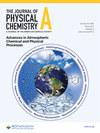(2-氯乙基)苯的热解反应。
IF 2.8
2区 化学
Q3 CHEMISTRY, PHYSICAL
引用次数: 0
摘要
热解聚氯乙烯(PVC)被认为是传统的机械回收方法的替代方案。然而,对PVC的热分解途径,特别是化学回收过程中产生的氯化烃的去向研究不足。PVC热解的一个重要产物是(2-氯乙基)苯。利用超热管式反应器和基质分离FTIR技术,对气相(2-氯乙基)苯的热解产物进行了鉴定。1400k热解后,FTIR光谱显示生成了HCl、苯乙烯、苯乙炔、苯、乙烯乙炔、乙炔、丙炔、乙烯和丙炔自由基。本文章由计算机程序翻译,如有差异,请以英文原文为准。
Pyrolysis Reactions of (2-Chloroethyl)benzene
Pyrolysis of polyvinyl chloride (PVC) is considered an alternative to traditional, mechanical methods of recycling. However, there is insufficient research conducted on the thermal decomposition pathways of PVC, particularly the fate of chlorinated hydrocarbons generated during the chemical recycling process. One significant product from the pyrolysis of PVC is (2-chloroethyl)benzene. Using a hyperthermal tubular reactor and matrix-isolation FTIR techniques, the pyrolysis products of gas-phase (2-chloroethyl)benzene were identified. Following pyrolysis at 1400 K, the FTIR spectra indicated the formation of HCl, styrene, phenylacetylene, benzene, vinylacetylene, acetylene, propyne, ethylene, and propargyl radical.
求助全文
通过发布文献求助,成功后即可免费获取论文全文。
去求助
来源期刊

The Journal of Physical Chemistry A
化学-物理:原子、分子和化学物理
CiteScore
5.20
自引率
10.30%
发文量
922
审稿时长
1.3 months
期刊介绍:
The Journal of Physical Chemistry A is devoted to reporting new and original experimental and theoretical basic research of interest to physical chemists, biophysical chemists, and chemical physicists.
 求助内容:
求助内容: 应助结果提醒方式:
应助结果提醒方式:


